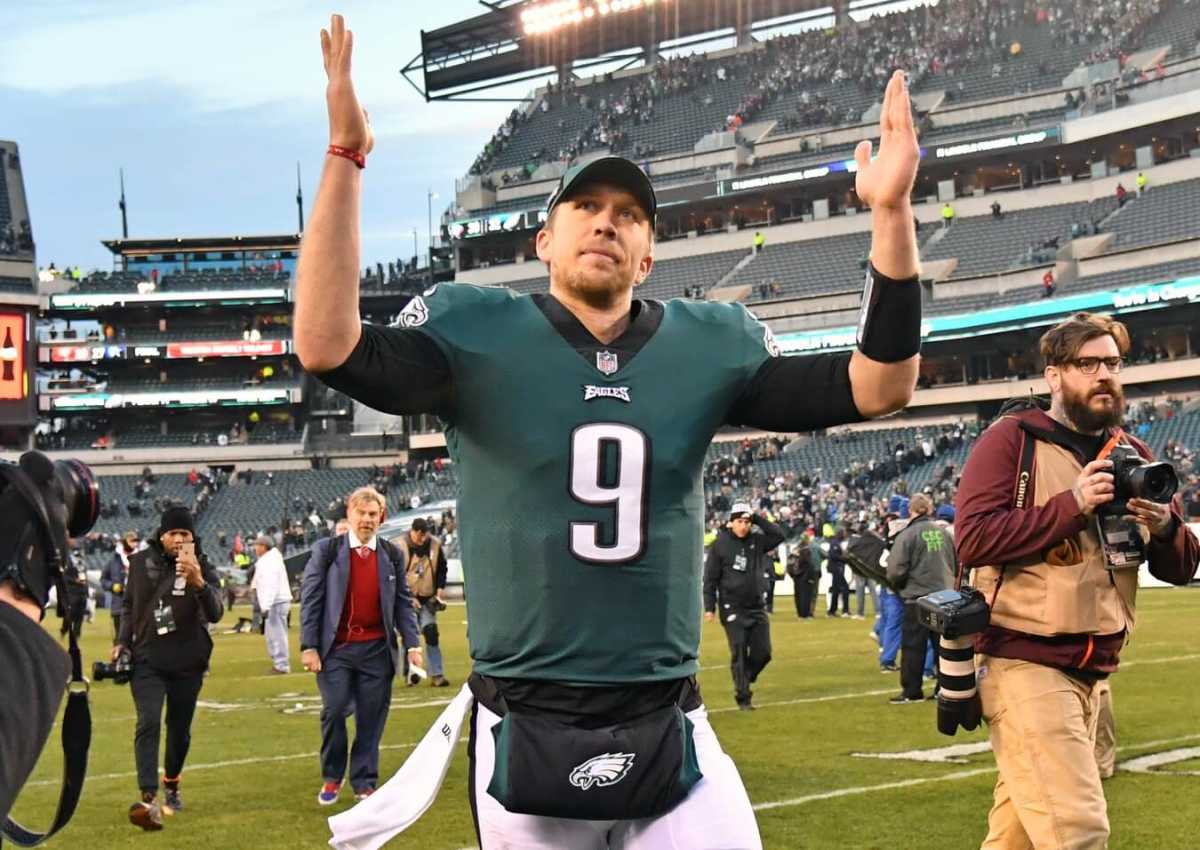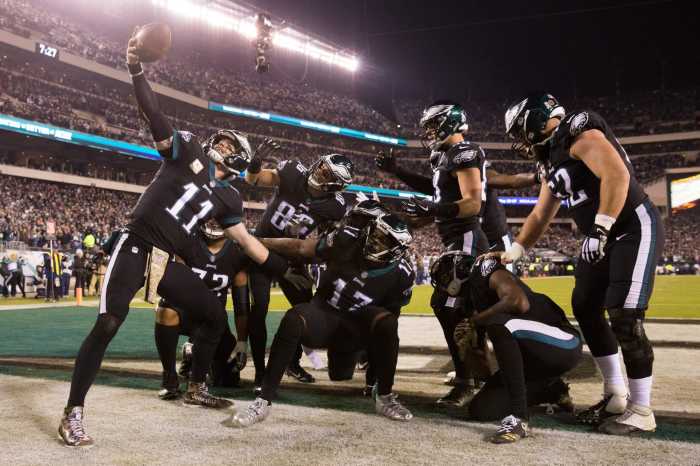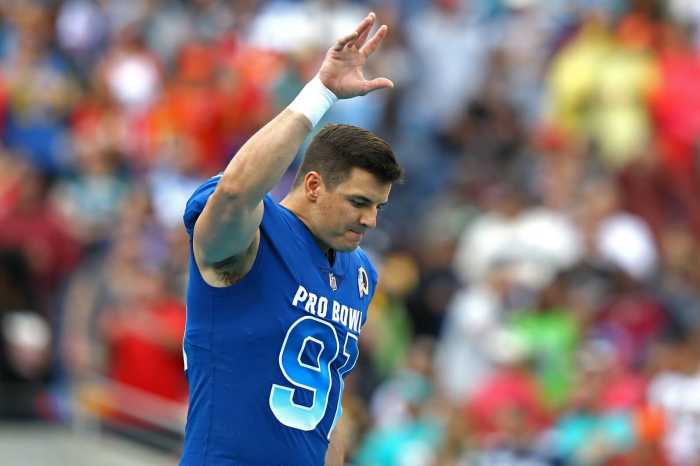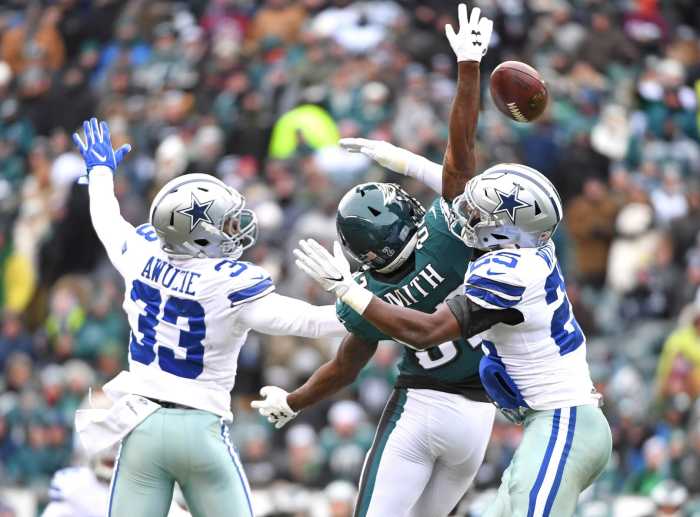As the Eagles head into the final game of the 2018 regular season, Carson Wentz will watch from the sidelines while Nick Foles takes on the Washington Redskins for a shot at the last NFC wild card spot. Struck with a late blooming controversy, sparked by a spat of impressive play from Foles, many Eagles fans have flipped their opinion on Wentz’ future as a starter in Philly. The debate has been pretty black and white — either you and your buddies think Wentz is the future and Foles is a career backup who has been playing his heart out for the best city in America; or rather that Foles is the answer at the head of the offence and Wentz is an injury-prone might-have-been for Philadelphia nostalgia-seekers. While there is no denying Foles’ incredible ability to keep Eagles’ hopes alive late into the winter, the naysayers haven’t truly given Carson a fair shot. Coming off a major injury this off-season, and playing through a nagging back injury through most of the season, Wentz never really looked like himself in the 2018 season. The Eagles offence followed suit. Now, with Foles under centre, the offence has gotten the shot in the arm they needed and many are unduly attributing the offensive failures to Wentz.
Here on crunching the numbers, I’ll aim to give an objective opinion of the film and the statistics. This series will be divided into two parts, for the sake of length. First, it is important to understand the underlying tide that has been pushing the familiar wave of explosive Eagles performances. There are five major team factors that have pushed a new hope in Philadelphia: blocking, rushing touchdowns, the return of Darren Sproles, the resurgence of Alshon Jeffrey, the terrifying two tight end sets, and the return to preeminence on defence. After calming those quandaries, part two will dive into a little film to examine the difference each quarterback brings to the Eagles offence.
Blocking
The last two games with Nick Foles at pivot, the Eagles offensive line have faced two impressive defensive lines. The LA Rams, while not seeing the success rushing the passer that their roster would entail, still have the star power — namely Aaron Donald and Ndamukong Suh — to disrupt an entire offense. The team then welcomed the Houston Texans with two of the most dominant pass rushers in the league in J.J. Watt and Jadaveon Clowney. The line allowed an unbelievable one total sack in both games, which came against the Texans. With Foles starting, the line has allowed 1.5 sacks per game, including games against Atlanta and Tampa Bay early in the season.
With Wentz calling the shots, Philadelphia didn’t face any defensive line that strikes fear into the hearts of opponents, save for the Minnesota Vikings and the Dallas Cowboys. The Indianapolis Colts have also had some surprising performances on defense. During that stretch of eleven games, the line allowed 2.73 sacks per game. Now, this is definitely indicative of a crucial hidden element in Carson’s 2018 performance, but the fact is, the line has been significantly better under Foles. Protection Rate for Wentz in 2018 is registered at 82%, 2% higher than Foles. However, this is namely due to some incredible individual game performances with Wentz, and a bad showing against the Falcons in the first game of the year. Last season, Carson had the benefits of an 88.7% protection rate.
Rushing Touchdowns
While it is a fallacy to say the run game has been overtly better with Nick under centre, there has been a key factor feeding the success of the offense. The offense averages 25.75 attempts and 93 yards per game with Foles as the starter and 23.72 attempts and 97 yards with Wentz. The difference is that the rushing offense has been responsible for 1.75 touchdowns per game under Foles and only 0.45 per game under Wentz. This puts a ton of pressure on Wentz to be the primary points manufacturer in the offense. Last season, the offense only scored nine total rushing touchdowns. However, they had unsustainable success in red zone scoring percentage. This year, with opposing defenses getting wise to the Doug Pederson red zone offense, the team needed the running game to step up in a big way. It has under Foles.
The Return of Darren Sproles
While Sproles isn’t known to be an every-down rush-heavy running back, his influence on the team’s run game is heavily understated. The Eagles pass offense depends immensely on their ability to run quick passes out of the backfield and draw plays from the shotgun. Josh Adams enjoyed some success rushing the football under Carson Wentz, but he was only used in the shotgun on 44.0% of his run plays. Accordingly, Corey Clement saw his role slowly diminish. Under Foles there has been a transition back towards Wendell Smallwood and Sproles; which most likely would have included Clement if he was healthy. Clement took 63.2% of his snaps from the shotgun and averages 4.6 yards per tote in those situations. Smallwood takes 72.0% of his handoffs in gun, but only averages 4.1 yards per carry. Since returning, Sproles has taken half of his handoffs from shotgun and has averaged a whopping 5.2 yards per carry. His importance is felt even more so in the passing game.
There is no other running back on the Eagles roster that requires the attention, or showcases the ability that Sproles does in the passing game. There is an example of Wendell Smallwood running essentially the same play against the Rams, in which he is stopped on third down. The Rams vs. Eagles highlights are linked below, and you can see said play at 1:57, as well as Sproles ability on draw plays at 0:24. Wendell is unable to catch the ball seamlessly in stride, admittedly due a less-than-stellar ball from Foles, and does not have the shake to make defenders miss like Sproles does.
The commotion that Sproles causes for defences in the pass game is perfectly displayed on an easy pitch and catch for Foles and Ertz against the Texans. At 15:11, the linebacker runs into the back of his defensive back scrambling to cover Sproles in the flats, leaving Ertz wide open.
The Resurgence of Alshon Jeffrey
For whatever reason, Alshon and Foles have a chemistry the same as old high school darlings finding each other after decades apart. This may have to do with the fact that the pair worked together all off-season while Wentz was away rehabbing his torn ACL. It may also require a long look into the Carson Wentz – Zach Ertz love affair which at some times kept the young quarterback afloat, and at others was his undoing. Aside from a dominant performance against the Tennessee Titans, Jeffrey nearly dissipated this season with Wentz in the huddle. The only thing Alshon hasn’t done with Nick under centre is find the end zone. This could be because of the aforementioned success of the run game, or the fact that they haven’t really needed him to score. Every other number goes up for the second-year Eagles receiver when Foles takes over at Q:
| Alshon Jeffrey | With Foles | With Carson |
| Receptions per Game | 5.5 | 4.9 |
| Targets per Game | 6.5 | 7.4 |
| Yards per Game | 121 | 54.2 |
| Touchdowns per Game | 0 | 0.5 |
As made evident by the numbers, there is not necessarily an issue with the amount of targets, more so the type of targets. Foles is willing to throw up contested balls over the middle for Alshon to go up and make a play on — and he has been rewarded. With Wentz, most of Alshon’s targets were to the outside, and generally shorter distances. The open areas in the middle of the field are namely due to a change in personnel. The first route tree is an example of Alshon’s better games with Wentz. The second shows his receptions against the Rams. You’ll notice the completions over the middle made all the difference.
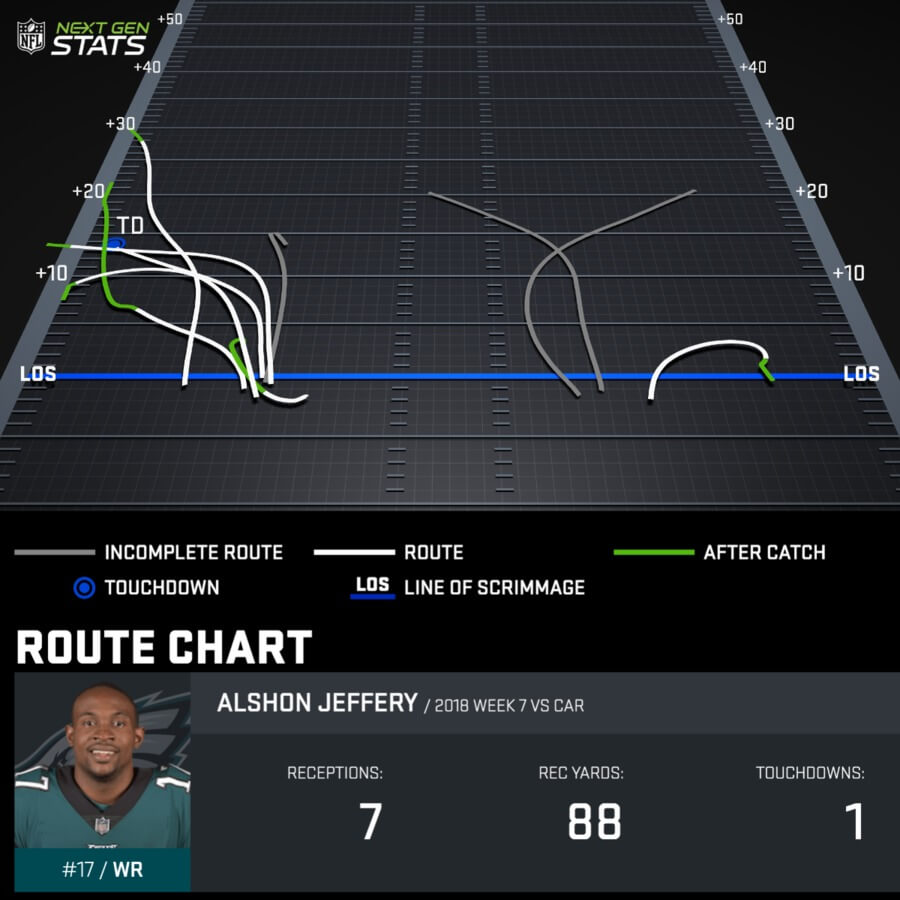
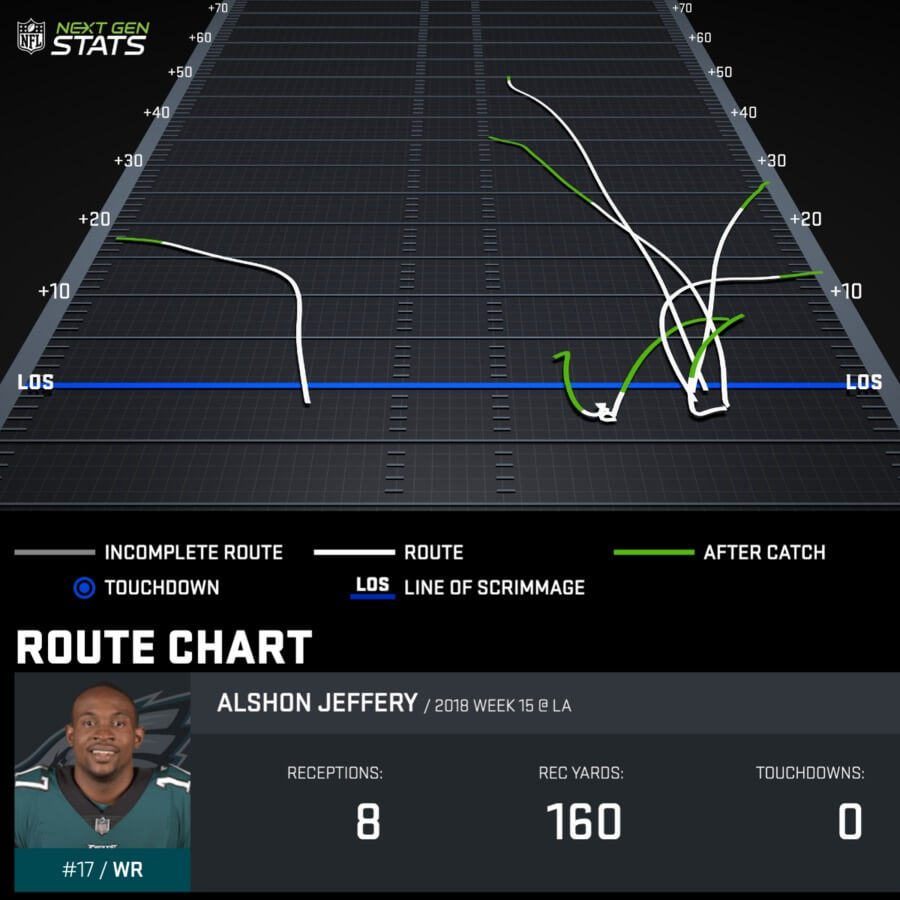
The first completion over the middle can be seen at 4:21 of the Eagles vs. Rams highlight video below. Zach Ertz and Nelson Agholor run seams, with Alshon running a lazy dig over the middle. Instead of being the primary focus of the offence, Ertz functioned mainly as a scapegoat against LA. You’ll notice Talib has his eyes on Ertz, expecting the throw to go his direction. Instead, Foles is entirely willing to throw the ball to Alshon early in the route with the trust that Jeffrey will go up and make a play on the ball. This trust has not been seen between he and Wentz.
On the next play, Foles continues to feed the hot hand. This is a telling instance of what we will be discussing next — 12 personnel. With two tight ends in the game, the Rams are forced to respect the run, and bite up on the play fake to Josh Adams. It also necessitates a zone defence on the back end, and when Nelson runs deep, the corner slips on his break on the ball, leaving Alshon wide open. With a better pass from Foles, this play probably would have been a touchdown.
The result of Alshon’s uptick in use is in full effect at 9:40. With Talib having his hands full covering the larger, more athletic Jeffery, his attention is fully consumed by the task. Thus, Ertz comes wide open in the flats and he has plenty of space for some solid yards after the catch.
The Terrifying Two Tight End Sets
A fantastic article by Bleeding Green Nation’s Benjamin Solak showcases the new life the 12 personnel set has given to the Eagles offense. I recommend you check out the article through the link below, but essentially the 12 personnel set (one running back, two tight ends, two receivers) allows the offense to create match up nightmares for opposing defense putting their two terrifically talented tight ends on the field together. It forces defenses to play zone more often because they do not have the requisite talent to cover both Zach Ertz and Dallas Goedert mono e mono. It also forces the defense into base defense for fear of getting caught outnumbered on running plays. Dallas Goedert has been especially impressive in run blocking early on in his career. This opens up the middle of the field for Alshon, as there isn’t an extra, pesky defensive back ball-hawking over the middle of the field, and he is able to find holes in the zone defense. The aforementioned deep bomb from Foles to a wide open Alshon Jeffrey or Nelson Agholor, we’re not sure which, is a fantastic example, as well as the 10 yard out route that was also discussed. There are also many other cases expertly illustrated in the link below by Mr. Solak.
Below is a chart of 12 personnel usage over the course of the season, per Bleeding Green Nation. The acquisition of Golden Tate, and the concurrent over-attempt to get him involved in the offence did more harm than good.
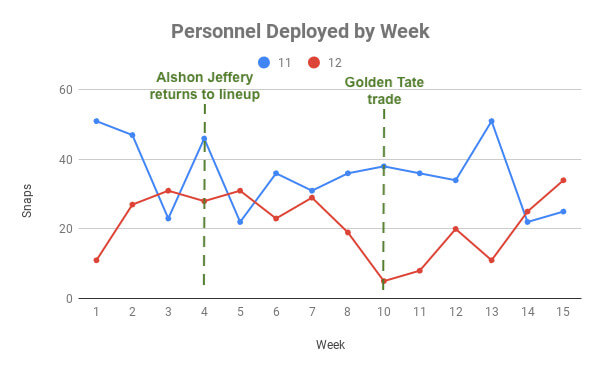
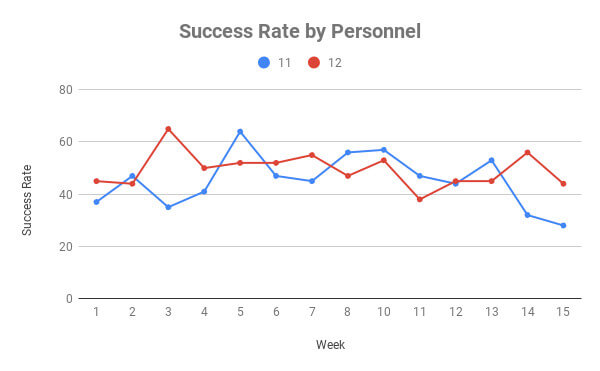
Defensive defiance
With all the injuries hanging over the head of Defensive Coordinator Jim Schwartz, it’s no surprise that the defense has struggled this season. Nevertheless, they have been able to hold their own in the last few games as the young replacement players are starting to find their legs. They were actually impressive against a high-flying Rams offense. With a dearth of starting level talent in the secondary, the defense has been overly simplistic in the past weeks, but Schwartz has cleverly deployed a bend-but-don’t break style approach that has been money close to the end zone. Despite having the benefit of a healthy secondary early in the season, the defense was not better when Carson was at the helm of the offense.
With Foles calling shots, the defense has allowed an average of 23.0 points per game. This is hardly a vast improvement over the 23.3 points per game they allowed under Wentz. However, with Saint Nick under centre, the defense has averaged 1.75 takeaways per game — 0.75 interceptions and 1 fumble recovery — and 3 sacks per contest. They averaged only 0.82 takeaways per game — 0.55 interceptions and 0.27 fumble recoveries — and 2.55 sacks for Wentz. Admittedly, some of these fumbles have come from special teams, and the Eagles had some unfortunate calls with turnovers in earlier games.
The deviation in performance becomes even more significant when examining the Eagles opponents during each quarterbacks reign. Under Foles the defence faced the 8th, 3rd, 2nd and 15th ranked offense — according to current rankings. Wentz had the pleasure of facing the 7th, 26th, 17th, 19th (twice), 11th, 27th, 21st (twice), 6th and 28th ranked offence. Therefore, a similar points allowed result under both quarterbacks is ultimately unacceptable. A majority of the injuries made their impact in the back end of Wentz’ time at pivot, however, the defence was also at their healthiest under Wentz, to no avail.
Therefore, based solely on the numbers, one could make the argument that the total team performance has been the cause of the Eagles new found success with Foles. Nevertheless, even casual Philly fans could tell you, the tape shows a different story. Thus, we must examine the individual games of each QB to determine the true cause of the return to winning ways. Come back to see the second portion of this in depth look at the Wentz versus Foles debate.
Mandatory Credit: Eric Hartline-USA TODAY Sports

